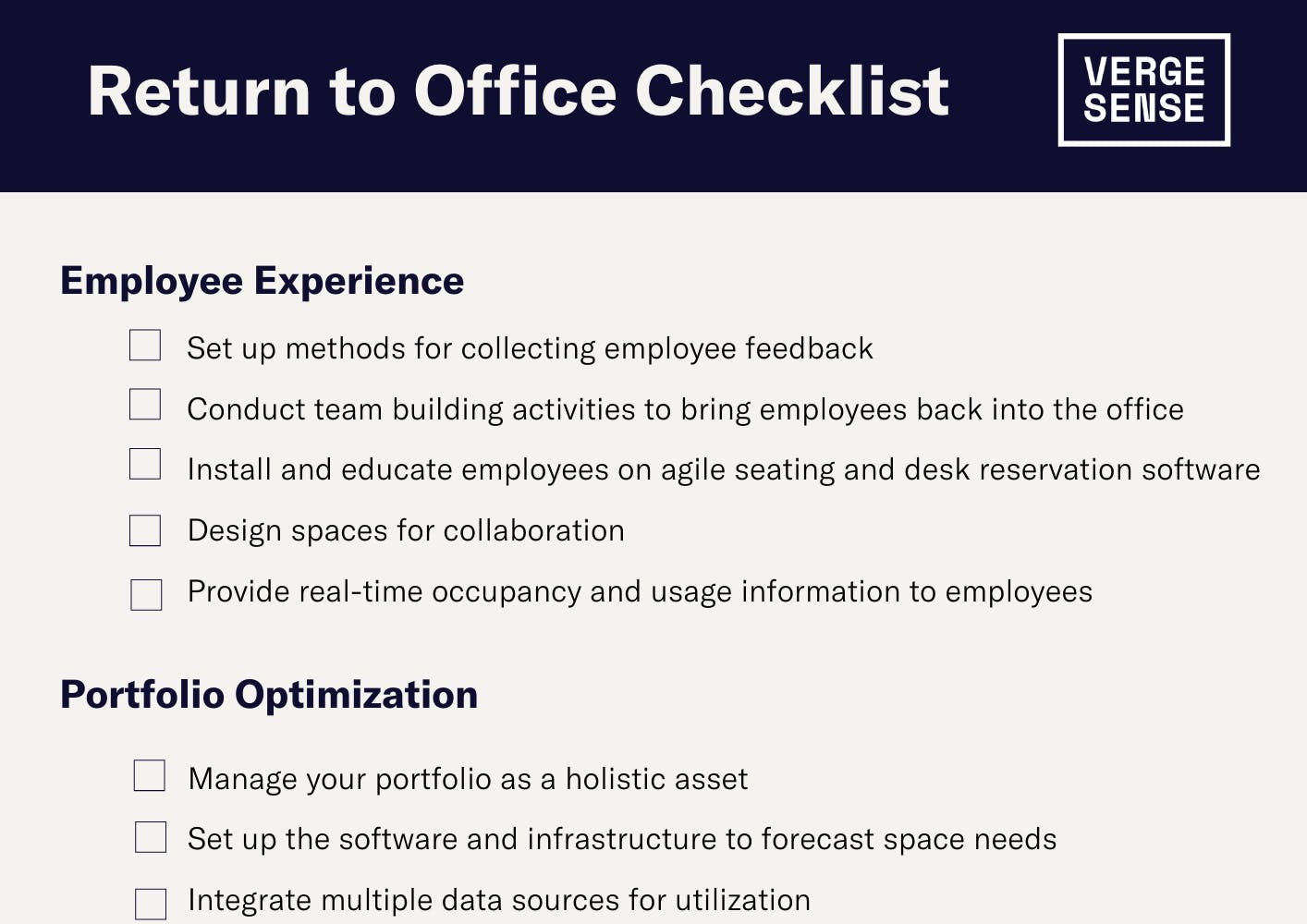VergeSense is the industry leader in providing enterprises with a true understanding of their occupancy and how their offices are actually being used.
The return to office after a year and a half of remote work has arrived, and with it business leaders are finding themselves making ongoing decisions to dictate what exactly this return will look and feel like for their employees. With 74% of businesses returning to the office saying that they plan to return hybrid, it’s clear that implementing flexible workplace policies is a driving force behind the return.
For those leaders who are new to hybrid work, they may be wondering where to start when approaching this return. Not only where to start approaching it, but how to plan a return to the workplace that meets employee needs and prioritizes safety, collaboration, and productivity.
We’ve created a return to office checklist to help you with exactly that— to act as a resource alongside your return to office strategy that can be used to ensure no hybrid stone is left unturned as you restructure your office space and welcome teams back into the office.
Of course, the challenges that face every company during this return will differ depending on their existing office layouts and the specific needs of their employees. While this return to office checklist is a useful tool, we recommend that it be tailored to the unique needs of your organization’s return strategy.
How to Create your Return to Office Transition Plan
In order to create a thorough return to office transition plan and customized checklist that speaks to the needs of each of your departments, your infrastructure, and your individual employees you first need to take stock of your current systems to look for areas primed for optimization.
Step One: Survey your employees.
When you return to the office the lives that will be most primarily affected are those of your individual employees. Therefore, to create a truly comprehensive and sustainable return to office strategy and checklist, you first need to survey your employees to gain a deeper understanding for how their needs have evolved during the time they’ve spent out of the office.
Consider the following questions for an employee survey:
- What does your ideal workspace look like?
- What is your ideal hybrid schedule?
- What is your primary motivator for returning to the office/what are you most looking forward to when returning to the office?
- Can employee communication be improved? If so, how?
- Do you feel safe returning to the office? If not, what can we do to make you feel safe?
Once you’ve surveyed your team members and gathered insights into their expectations around returning to the office, you’ll be able to begin crafting your return to office checklist with an eye to the lived experience of your employees.
Step Two: Audit your current office space.
Once you’ve gained a clear understanding of what your employees expect from the return to office, it’s time for you to conduct a final audit of your current office space in order to identify areas that can be optimized for hybrid work.
Did you know?
74% of organizations returning to the workplace are adopting a hybrid work model.
During this auditing process, walk through a typical day in the life of one of your employees and ask yourself questions such as:
- Does your room/desk booking software work? Have you tested it?
- Have you determined a schedule for coming in?
- Did you decide on capacity limits for your total office and each work area?
- Are you able to measure people coming in and out of the office?
- Are meeting rooms optimized to support hybrid collaboration?
- Does your existing tech lend itself to a hybrid work model?
- What areas will benefit from the implementation of new tech?
- Is each workspace accessible to all employees?
This self-audit should be a twin resource to what you’ve just learned about your employee expectations. Once you’ve completed your return to the workplace audit, you can begin writing a return to office checklist that is specifically tailored to the needs of your employees.
How can employers adapt the workplace experience for the return to office?
Workplace strategy leaders and business leaders are thinking about the employee experience, encompassing both safety and workplace design. How can organizations best mimic the comforts of home that employees have grown accustomed to, but in the workplace setting? How can companies add or improve upon their workplace so that it offers opportunities that employees cannot get at home, so that they want to come back to the office? By prioritizing the employee experience, organizations can improve employee retention and bring in top talent based on the company culture.
No organization wants to make their team members feel uncomfortable while they are at work, especially during the process of welcoming them back to the office after over a year away. In order for business leaders to ensure their workforce that the return to office is in the best interest of everyone, think about comfort, preferences, safety, employee benefits, and logistics.
Here are some recommendations for employers preparing for their employees’ return to the office:
- Outline all of the health and safety protocols you will be implementing, to show your employees all of the steps that are being taken to protect their wellbeing.
- Invest in workplace analytics platforms to measure and analyze how different business units will need to use the workplace (for example: the engineering team may want bean bags while legal may need privacy rooms).
- Consider how different workstyles and collaboration needs will change
- Think about how you can maximize collaboration and team interaction in the office through updated workplace design & amenities, like more collaborative spaces, booking software, and other high-tech employee needs.
- Provide employee-driven hybrid working options, like collaborative meeting spaces, individual, bookable desks, and occupancy monitoring to offer transparency into the real-time state of the building or floor.
- Share frequent updates with your staff in regards to your company's responses to COVID-19, so they aren’t left guessing how you are continuously navigating the pandemic.
- Maintain a clear line of communication for all employees at all times.
- Establish an employee exposure plan in the event of an on-site employee testing positive for COVID-19.
- Continuously update your COVID-19 response plan in accordance with your employees comfort levels.
Crafting a Data-Driven Return to Office Checklist
The most thorough return to office checklists are those that have been informed by workplace usage data. When you make data-informed decisions about the future of your workspace and the return to office, you’ll be setting yourself and your teams up for more sustainable success in the future.
Remember, your return to office checklist isn’t intended to serve as a one-and-done placeholder until you pivot your workspace again in the future. Instead, it is intended to serve as the foundation for the long term structural and personnel policies you’ll be implementing to support your new hybrid workforce.
The benefits of making a data-driven return to office checklist include:
- You will be able to take a more proactive and adaptable approach to the return to office than if you were to make uninformed decisions.
- You will be able to better identify opportunities for cost savings.
- When you have data to back up your decisions, you’ll be able to share it with your employees.
- You will be able to influence change within your organization with confidence because you have the data to back up your strategic visions.
Data-informed decisions are at the heart of progress. The VergeSense workplace analytics platform is primed to help you begin integrating data into your decision making processes today.
For enterprises forming a return to office strategy that focuses on employee experience, people-counting technology is essential. VergeSense’s enhanced Workplace Analytics Platform and Return to Office Dashboards are an accurate and comprehensive solution to keep a pulse on real estate usage, utilization data, and detailed people reporting.
With the new Return to Office Dashboards, get actionable data to bring your return to office strategic visions to life. Answer these crucial workplace design and employee experience questions in a glance:
- How many people are in the office today?
- Where are people sitting today?
- Is space occupancy exceeding capacity today?
- What is the overall utilization across my buildings, floors, and spaces?
- What day and time should people come to the office?
- Which spaces are popular?
- How are my assigned and unassigned spaces being used?
To help you stay strategically focused during the Return to Office process, save this checklist.
Return to Office Checklist
Your Return to Office Checklist
Employee Experience
Set up methods for collecting ongoing employee feedback
Conduct team building activities to reintegrate employees with the office
Ensure that your workplace processes are compatible with hybrid work
Install and educate employees on agile seating and desk reservation software
Design spaces for collaboration
Provide real-time occupancy and usage information to employees
Identify opportunities to implement hybrid policies
Portfolio Optimization
Manage your portfolio as a holistic asset rather than individualized assets
Set up the software and infrastructure to forecast future space needs
Integrate multiple data sources for utilization and occupancy data to provide a 360-degree context
Evaluate current corporate real estate portfolio
Improved Operations
Establish communication best practices for on-site and remote work
Maximize your real estate investments with agile seating and workplace analytics data
Gather data to determine where and when teams work best, then identify which hybrid or flexible schedules your employees will use
Make the best use of meeting rooms and desks, release spaces when unused automatically
Optimize facility cleaning with occupancy data
Workplace Design
Reassess your workplace structures, layout, and dynamics
Optimize workplace design for activity-based working
Reorganize and rewire meeting spaces to support hybrid work
Organize space according to cross-functional teams and rethink office design for a hybrid workforce
Learn the best practices for bringing employees back into the office.
With a strategy in place to update the office for the return of employees and encourage them to take advantage of office spaces, organizations can improve employee experience and make better use of existing real estate investments.
To learn more about how to best support a returning workforce, join us for a live product walkthrough on September 14th, 2021: How to Answer Critical Return to Office Questions with VergeSense. During this session, we’ll demonstrate a live walkthrough of the VergeSense workplace analytics platform, newly optimized for your Return to Office strategy.

